The outside of the home can use a variety of materials, depending on when the house was built, where it is located, and the preferences of the owner. Each type of siding material has its own advantages and disadvantages. Think about what your personal style is, and if the home will need to be protected from certain weather conditions. Other things to keep in mind when selecting siding is your budget. Below, we go into the pros and cons of each type of siding.
Vinyl Siding
Photo by Katie Wasserman on Unsplash
Vinyl siding is made from PVC, and it is lightweight and durable. It can be manufactured to resemble wood or other materials for a lower cost.
You can find it in many different styles, like horizontal panels, vertical panels, shakes, Dutch lap, shakes, shingles board and batten, fish scales, beaded or scallops.
While it is water resistant, it is not waterproof. Make sure that it is installed correctly to resist mold. With extreme weather conditions, it might warp.
Another thing to keep in mind is that vinyl siding cannot be painted. Whichever color that you choose is the one that you’ll have for as long as you have the siding.
Some benefits of vinyl siding are that:
- It can last more than 40 years
- Is more weather resistant than metal
Vinyl siding is the most popular siding choice in America. More than 90% of the homes in America use PVC siding. There are many looks, colors, and textures available. Made from a PVC plastic resign, it will not chip, rust or rot.
Vinyl siding is also quick to install, which will save you money on labor costs. It is easy to maintain, and any dirt will simply wash off. Another good thing is that vinyl siding will never need to be repainted.
Another thing about vinyl siding is that it is lightweight. It can also be installed directly over any existing siding. This makes it a great retrofit option.
Vinyl is fire resistant so it’s a safer option.
Cons
- Very common so your house won’t stand out
- Made with artificial chemicals
- Panels come in standard 12 ft lengths, so the panels might overlap
Stucco

Photo by Landis Brown on Unsplash
Stucco is a very durable choice in siding material. It will pair well with other siding materials, and it adds an architectural design to a job that is retrofitted.
There is natural, synthetic, and hybrid stucco.
Stucco mixtures include epoxy. In order to install stucco, you will need the help of an experienced stucco contractor or handyman. Stucco that is maintained well can last a lifetime.
You can add toners to stucco mixtures to create beautiful, organic colors that will go all the way through a material. This means that repainting will be unnecessary.
Stucco can’t be painted immediately after it is installed. It is also not a good choice for areas with heavy, consistent rainfall.
Stucco is fire resistant, so this would be a good choice if you are concerned about fires.
Pro
- Low maintenance material
- Resistant to insects and fire
Cons
- Requires a lot of prep work
- It could potentially crack
Wood Siding
Photo by Louis Renaudineau on Unsplash 
Wood siding has a natural beauty and charm that makes the home stand out. It is workable and also is warm. Choose this for a premium renovation project.
You can choose from wood siding options like board and batten, clapboard, plywood, hardboard, shingles and engineered.
There are many grades and species available to choose from when selecting to work with wood siding. The type that you choose depends on the way you plan on finishing the siding. You can use a semi-transparent stain that highlights the grain or a clear sealer if you choose a more expensive wood grade that does not have blemishes or knots.
If you’re planning on painting it or using an opaque stain, then you can choose a less expensive grain.
When you are good about maintaining it, wood paneling can last for many years. You will need to reapply clear finishes every two years, redo semi-transparent stains every three years and paints every five years.
Wood siding is the most eco-friendly siding type that is available. It degrades easily when it is disposed of.
It is also easy to replace if it gets damaged. However, wood siding is not resistant to fire or insects.
Pros
- Beautiful and warm
- Natural material
- Easy to shape and cut
Cons
- More expensive
- Refinishing can cost from $2,000 to $5,000
These three types of siding options are excellent choices for your home. With the help of a professional, you can find the right choice for your style and for your budget. Be sure to take into consideration the weather conditions and whether or not you’ll want to paint it after you install it, and find a style you like.
Author Bio-
Edward Flanagan is the founder of Edward’s Enterprises, a handyman service & licensed general contractor that has been improving homes and providing facilities maintenance in Southern California since 1996. Their handyman services include stucco patches, drywall repairs, and interior & exterior painting. Edward currently divides his time between Camarillo and Venice Beach, CA, and loves the 405.



